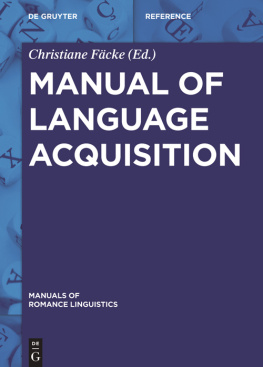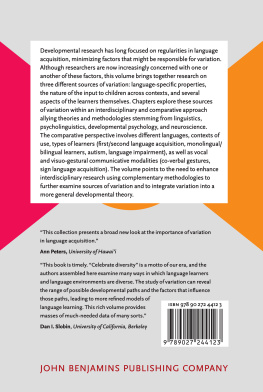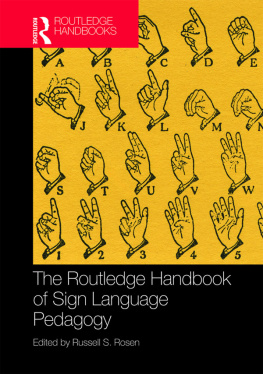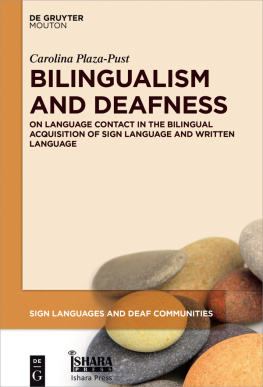Sign Language and Language Acquisition in Man and Ape
New Dimensions in Comparative Pedolinguistics
AAAS Selected Symposia Series
Sign Language and Language Acquisition in Man and Ape
New Dimensions in Comparative Pedolinguistics
Edited by Fred C. C. Peng
First published 1978 by Westview Press, Inc.
Published 2019 by Routledge
52 derbilt Avenue, New York, NY 10017
2 Park Square, Milton Park, Abingdon, Oxon OX14 4RN
Routledge is an imprint of the Taylor & Francis Group, an informa business
Copyright 1978 by the American Association for the Advancement of Science
All rights reserved. No part of this book may beprinted or reproduced or utilised in any form or by any electronic, mechanical, or other means, now known or hereafter invented, including photocopying and recording, or in any information storage or retrieval system, without permission in writing from the publishers.
Notice:
Product or corporate names may be trademarks or registered trademarks, and are used only for identification and explanation without intent to infringe.
Library of Congress Catalog Card NumberL: 78-19807
ISBN 13: 978-0-367-28727-6 (hbk)
About the Book
This volume brings together recent research findings on sign language and primatology and offers a novel approach to comparative language acquisition. The contributors are anthropologists, psychologists, linguists, psycholinguists, and manual language experts. They present a lucid account of what sign language is in relation to oral language, and of the capacity of nonhuman primates to learn specific, human-origin language systems. The papers give a contrastive view of man and ape, as well as a general overview of comparative language acquisition.
In the first half of the volume, sign Language is put in a cultural context and assessed from historical and contemporary perspectives. It is seen not as a self-contained entity but rather as a general norm of individual sign activities that rapidly develop and change in any given society. Moreover, sign language, a system of the visual mode and the brachial apparatus, is shown to be useful for measuring the similarities and differences between man and ape.
The second half of the volume is concerned with the assessment of research in which signing apes are compared with humans and with' each other, using sign language (or some other visual sign mode) as a yardstick. The purpose of this comparison is the search for a common precursor of human and nonhuman corrmunication systems, and ultimately, the discovery of a general faculty shared by man and ape.
Contents
-- Fred C. C. Peng
-- Fred C. C. Peng
-- Nancy Frishberg
-- Frank Caccamise, Richard Blasdell and Charles Bradley
-- Lyn W. Miles
-- Roger S. Fouts
-- Duane M. Rumbaugh, E. Sue Savage-Rumbaugh and Timothy V. Gill
-- Francine Patterson
-- Fred C. C. Peng
-- Gordon W. Hewes
The AAAS Selected Symposia Series was begun in 1977 to provide a means for more permanently recording and more widely disseminating some of the valuable material which is discussed at the AAAS Annual National Meetings. The volumes in this Series are based on symposia held at the Meetings which address topics of current and continuing significance, both within and among the sciences, and in the areas in which science and technology impact on public policy. The Series format is designed to provide for rapid dissemination of information, so the papers are not typeset but are reproduced directly from the camera copy submitted by the authors, without copy editing. The papers are reviewed and edited by the symposia organizers who then become the editors of the various volumes. Most papers published in this Series are original contributions which have not been previously published, although in some cases additional papers from other sources have been added by an editor to provide a more comprehensive view of a particular topic. Symposia may be reports of new research or reviews of established work, particularly work of an interdisciplinary nature, since the AAAS Annual Meeting typically embraces the full range of the sciences and their societal implications.
WILLIAM D. CAREY
Executive Officer
American Association for
the Advancement of Science
Fred C. C. Peng, professor of linguistics at the International Christian University in Tokyo,kas studied many ccreas of linguistics and has published seven books and more than sixty articles, including On the Nature of Sign Language and Aspects of Sign Language (in Japanese; Bunka Hyoron Publishing Co., 1976 and 1977). He has lectured throughout the United States and Japan and his positions include secretary of the International Association for the Study of Child Language, director of the International Christian University Language Sciences Summer Institute, and secretary and cofounder of the Sign Language Society of Japan. Dr. Peng also holds editorial positions with five professional journals.
Richard. Blasdell , a research associate at the Manual Language Department of the National Technical Institute for the Deaf, is currently conducting a program of research into the physiological aspects of manual communications and speech in normal-hearing and deaf adults. A specialist in psycholinguistics and language acquisition, he is the author of numerous articles on manual language and other subjects.
Charles Bradley , a graduate student in physics at Washington University, was previously an interpreter at the National Technical Institute for the Deaf. He is a member of the Registry of Interpreters for the Deaf, with comprehensive certification, and he has published an article on technical signs standardization in the American Annals of the Deaf (February, 1977).
Frank Caccamise, chairperson of the Manual Language Department of the National Technical Institute for the Deaf , is responsible for research and instruction in manual/ simultaneous communication and for instruction of deaf students. He is currently chairperson and director of the Project on Technical Sign Standardization and Development and is the author of numerous publications, including some on the efficiency of various modes of communication with hearing-impaired individuals.
Roger S. Fouts , associate professor of psychology at the University of Oklahoma, works in the fields of psycholinguistics, primate behavior, and comparative psychology. His publications in these areas include "The Use of Guidance in Teaching Sign Language to a Chimpanzee (Fan Troglodytes)" in the Journal of Comparative and Physiological Psychology (1972) and "Communication with Chimpanzees" in E. EiblEibesfeldt and G. Kurth (eds.), Hominization and Verhalten (Verlag, 1975).
Nancy Frishberg , assistant professor of linguistics at Hampshire College, specializes in linguistic theory, the biological foundations of language, and sign languages of the deaf. She is a member of and certified by the Registry of Interpreters for the Deaf and the Sign Instructors Guidance Network (National Association of the Deaf), and has published several articles on sign language.















